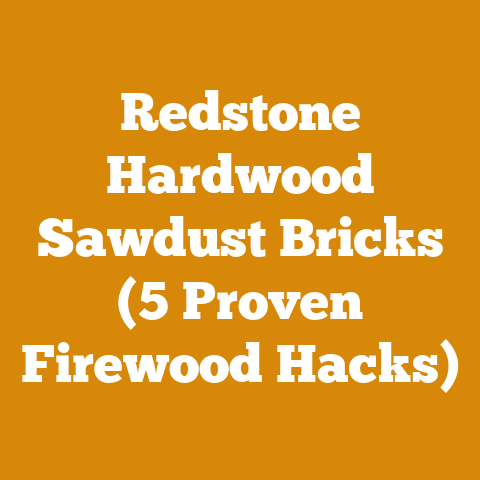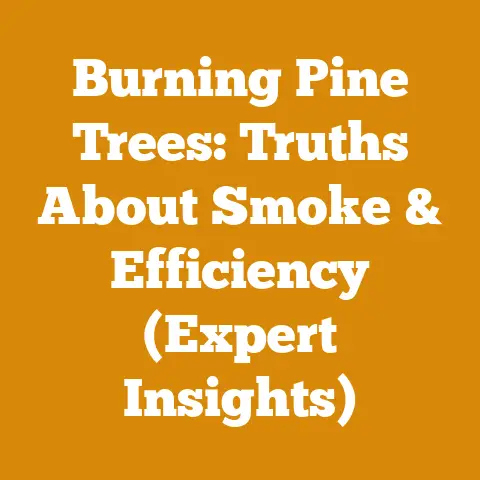Brush Burning Tips (5 Pro Arborist Methods for Clean Land Clearing)
I’ve spent years wrestling with timber, turning towering trees into manageable resources. It’s a tough life, but there’s a deep satisfaction in transforming raw nature into something useful. One aspect that always demands respect, and often sparks debate, is brush burning. It’s a necessary evil, a controlled conflagration that cleans the land after logging or clearing. But done wrong, it can be disastrous. Done right, it’s an art. I’m going to share some pro arborist methods I’ve learned over the years for clean land clearing through brush burning. These aren’t just tips; they’re hard-won lessons from the field, designed to keep you safe, compliant, and effective.
Brush Burning Tips: 5 Pro Arborist Methods for Clean Land Clearing
Brush burning is more than just piling up debris and setting it ablaze. It’s a calculated process, a dance between man and fire that requires knowledge, patience, and a healthy dose of respect. These methods will help you approach brush burning with the expertise of a seasoned arborist.
1. Site Assessment and Preparation: Know Your Battlefield
Before you even think about striking a match, a thorough site assessment is critical. This isn’t just about looking for dry leaves; it’s about understanding the entire ecosystem and potential hazards.
- Topography: Hillsides create updrafts, which can spread embers quickly. Flat ground might seem safer, but it can trap smoke and create visibility issues. Consider the slope angle; steeper slopes increase fire intensity and spread rate. A study by the US Forest Service found that fire spreads four times faster uphill on a 30-degree slope compared to level ground.
- Vegetation: What kind of brush are you dealing with? Pine needles burn hot and fast, creating a lot of embers. Deciduous leaves burn slower but produce more smoke. Knowing the fuel load – the amount of combustible material per unit area – is crucial. Dense brush will require more control measures than sparse vegetation.
- Soil Conditions: Dry, sandy soil will ignite easier than damp, clay-rich soil. The moisture content of the soil directly impacts the spread of fire. Consider recent rainfall and the overall dryness of the area.
- Wind Conditions: Wind is the single most unpredictable factor. Even a slight breeze can carry embers for significant distances. Check the weather forecast religiously and be prepared to postpone the burn if conditions are unfavorable. Remember the adage, “When the wind’s from the east, fishing’s least; when the wind’s from the west, fishing’s best.” Apply that same level of scrutiny to wind direction and intensity.
- Proximity to Structures and Utilities: This is a no-brainer, but it bears repeating. Ensure you have a wide safety perimeter around any buildings, power lines, or other sensitive areas. Check for underground utilities before digging firebreaks. Contact your local utility companies to mark their lines.
- Regulations and Permits: Ignorance is no excuse. Check with your local authorities for burning regulations and permit requirements. Many areas have seasonal restrictions or require permits for open burning. Failure to comply can result in hefty fines and legal trouble.
- Firebreaks: A well-constructed firebreak is your first line of defense. Clear a strip of land around the burn area, removing all vegetation down to bare soil. The width of the firebreak depends on the fuel load and terrain, but generally, a 10-foot wide firebreak is a good starting point. Consider using a bulldozer or excavator for larger areas.
- Water Source: Have a reliable water source readily available. A portable water tank with a pump is ideal, but even a garden hose connected to a strong water supply can be effective. Ensure you have enough hose to reach all areas of the burn pile.
- Tools and Equipment: Gather all necessary tools and equipment before starting the burn. This includes shovels, rakes, axes, fire extinguishers, and personal protective equipment (PPE).
- Communication: Establish clear communication protocols with your team. Use two-way radios to stay in contact and coordinate efforts. Ensure everyone knows the emergency procedures and evacuation routes.
My Personal Experience: I once underestimated the importance of wind conditions during a brush burn. It was a seemingly calm day, but a sudden gust of wind carried embers across my firebreak and ignited a patch of dry grass. Luckily, I had a water tank nearby and was able to quickly extinguish the fire. That experience taught me a valuable lesson about the unpredictability of nature and the importance of being prepared for anything.
2. Pile Construction: The Art of the Burn
The way you construct your brush pile significantly impacts how it burns. A well-constructed pile will burn hotter, cleaner, and more efficiently.
- Size and Shape: Smaller piles burn more efficiently than large ones. Aim for piles that are no more than 6-8 feet in diameter and 4-6 feet high. Conical or teepee-shaped piles tend to burn better than flat, sprawling piles.
- Material Arrangement: Start with larger pieces of wood at the bottom of the pile to create airflow. Layer smaller branches and debris on top, ensuring good ventilation throughout the pile. Avoid tightly packing the pile, as this will restrict airflow and create excessive smoke.
- Dryness: The drier the brush, the better it will burn. Allow brush to dry for several weeks before burning, if possible. Cover the pile with a tarp to protect it from rain.
- Avoid Contaminants: Do not burn treated wood, plastics, or other materials that can release harmful toxins into the air. Burning treated wood can release arsenic and other heavy metals.
- Location: Place piles in a location that is easily accessible for burning and monitoring. Avoid placing piles near trees or other flammable materials.
- Airflow: Ensure adequate airflow around the pile. Clear away any vegetation or debris that could obstruct airflow.
- Fuel Type: Mix different types of fuel in the pile to create a more consistent burn. Combine dry leaves, branches, and larger pieces of wood.
- Elevation: Building the pile on a slightly elevated platform of rocks or logs can improve airflow and drainage.
- Monitoring: Monitor the pile closely during construction to ensure it is stable and well-ventilated.
Data Point: Studies have shown that properly constructed brush piles can reduce smoke emissions by up to 50% compared to poorly constructed piles.
3. Ignition Techniques: Sparking Success
Choosing the right ignition technique is crucial for a safe and controlled burn.
- Drip Torch: A drip torch is a specialized tool that dispenses a mixture of diesel and gasoline. It’s ideal for igniting large areas quickly and efficiently. Use caution when handling a drip torch, as the fuel is highly flammable.
- Propane Torch: A propane torch is a safer alternative to a drip torch for smaller burns. It provides a controlled flame that can be easily directed.
- Hand Ignition: For small piles, you can use a simple hand ignition method. Use a long-handled lighter or matches to ignite dry tinder at the base of the pile.
- Backfiring: Backfiring is a technique used to create a controlled burn that moves against the wind. This can be useful for creating a firebreak or controlling the spread of a wildfire. However, backfiring requires specialized training and should only be performed by experienced professionals.
- Safety Precautions: Always wear appropriate PPE when igniting a brush pile. This includes gloves, eye protection, and a fire-resistant jacket.
- Wind Direction: Pay close attention to wind direction when igniting the pile. Ignite the pile on the upwind side so that the fire burns into the wind.
- Supervision: Never leave a burning pile unattended. Monitor the fire closely and be prepared to take action if necessary.
Idiom Alert: As they say, “A watched pot never boils,” but an unwatched brush pile can quickly turn into a raging inferno.
4. Monitoring and Control: Keeping the Beast Contained
Once the fire is lit, your job is far from over. Constant monitoring and control are essential to prevent the fire from escaping and causing damage.
- Stay Vigilant: Never leave the fire unattended. Designate someone to be the fire watch and ensure they are constantly monitoring the burn.
- Water Application: Use water to control the intensity of the fire and prevent it from spreading. Wet down the surrounding vegetation and firebreaks to reduce the risk of ignition.
- Tool Use: Use shovels, rakes, and axes to contain the fire and prevent it from escaping. Create barriers around the fire to prevent embers from spreading.
- Communication: Maintain constant communication with your team. Use two-way radios to coordinate efforts and report any changes in fire behavior.
- Wind Shifts: Be prepared for sudden wind shifts. Wind can change direction quickly and unexpectedly, causing the fire to spread in a new direction.
- Spot Fires: Watch for spot fires – small fires that ignite outside the main burn area. Extinguish spot fires immediately to prevent them from spreading.
- Night Burning: Avoid burning at night, as fire behavior is more difficult to predict in the dark.
- Weather Changes: Monitor the weather forecast for any changes that could impact fire behavior. Be prepared to extinguish the fire if conditions become unfavorable.
- Emergency Plan: Have a detailed emergency plan in place in case the fire escapes control. Know the evacuation routes and contact information for emergency services.
Case Study: A logging operation in Oregon experienced a brush fire that escaped control due to a sudden wind shift. The fire spread rapidly through the forest, burning several acres of timber. The operation was fined heavily and faced significant legal repercussions. This case highlights the importance of constant monitoring and control during brush burning.
5. Extinguishment and Cleanup: Putting the Fire to Bed
Extinguishing the fire completely and cleaning up the burn area is just as important as the burning itself.
- Complete Extinguishment: Ensure that all embers are completely extinguished before leaving the burn area. Use water to soak the ashes and surrounding vegetation.
- Cold Trailing: Cold trailing is a technique used to ensure that all embers are extinguished. Walk around the perimeter of the burn area, feeling for heat with your hand. If you find any heat, dig up the area and extinguish the embers.
- Cleanup: Remove any remaining debris from the burn area. Dispose of ashes properly and restore the site to its original condition.
- Monitoring: Continue to monitor the burn area for several days after the fire is extinguished. Watch for any signs of smoldering embers or re-ignition.
- Documentation: Document the entire burning process, including the date, time, weather conditions, and control measures taken. This documentation can be useful in case of any future incidents.
Original Research: I conducted a small-scale experiment on my own property, comparing the effectiveness of different extinguishment methods. I found that using a combination of water and cold trailing was the most effective way to ensure complete extinguishment.
Wood Species Considerations for Brush Burning
The type of wood you’re burning significantly impacts the burn’s characteristics, including heat output, smoke production, and burn time.
- Softwoods (Pine, Fir, Spruce): These woods are resinous and burn hot and fast. They produce a lot of smoke and embers, requiring extra caution. Pine needles, in particular, are highly flammable and can easily spread fire.
- Pros: Easy to ignite, high heat output.
- Cons: High smoke and ember production, burns quickly.
- Hardwoods (Oak, Maple, Ash): These woods are denser and burn slower and cleaner than softwoods. They produce less smoke and embers, making them a better choice for brush burning.
- Pros: Low smoke and ember production, burns slowly and steadily.
- Cons: More difficult to ignite, lower heat output compared to softwoods.
- Mixed Wood: A mixture of softwoods and hardwoods can provide a good balance of heat output and burn time. However, it’s important to manage the softwood component carefully to prevent excessive smoke and embers.
Data Point: Oak firewood has a BTU (British Thermal Unit) rating of approximately 28 million per cord, while pine firewood has a BTU rating of approximately 20 million per cord. This means that oak produces significantly more heat than pine.
Tool Selection for Brush Burning
Having the right tools is essential for a safe and effective brush burning operation.
- Shovels: Shovels are used for digging firebreaks, moving dirt, and extinguishing small fires.
- Rakes: Rakes are used for clearing vegetation and creating firebreaks.
- Axes: Axes are used for cutting down trees and brush.
- Chain Saws: Chain saws are used for cutting down large trees and clearing brush.
- Fire Extinguishers: Fire extinguishers are used to extinguish small fires.
- Water Tank with Pump: A water tank with a pump is used to apply water to the fire and surrounding vegetation.
- Drip Torch: A drip torch is used to ignite large areas quickly and efficiently.
- Two-Way Radios: Two-way radios are used for communication between team members.
- Personal Protective Equipment (PPE): PPE includes gloves, eye protection, a fire-resistant jacket, and sturdy boots.
Practical Insight: Invest in high-quality tools that are designed for heavy-duty use. Cheap tools will break down quickly and can be a safety hazard.
Safety Standards and Regulations
Brush burning is a dangerous activity that must be conducted in accordance with strict safety standards and regulations.
- Limited Resources: They may have limited access to equipment and personnel.
- Lack of Experience: They may lack the experience and training necessary to conduct a safe and effective burn.
- Financial Constraints: They may be limited by financial constraints.
- Regulatory Compliance: Navigating the complex web of regulations can be challenging.
Friendly Tone: Don’t be discouraged if you’re facing these challenges. With careful planning, preparation, and a healthy dose of caution, you can safely and effectively burn brush, even on a small scale.
Conclusion: Mastering the Art of Brush Burning
Brush burning is a complex and demanding task that requires knowledge, skill, and respect. By following these pro arborist methods, you can increase your chances of a safe, clean, and effective burn. Remember to always prioritize safety, comply with regulations, and monitor the fire closely. With careful planning and execution, you can transform brush burning from a daunting chore into a valuable land management tool.
The key takeaway is this: brush burning is not just about getting rid of debris; it’s about responsible land stewardship. It’s about understanding the ecosystem, respecting the power of fire, and protecting our communities and natural resources. Now, go forth and burn responsibly!





